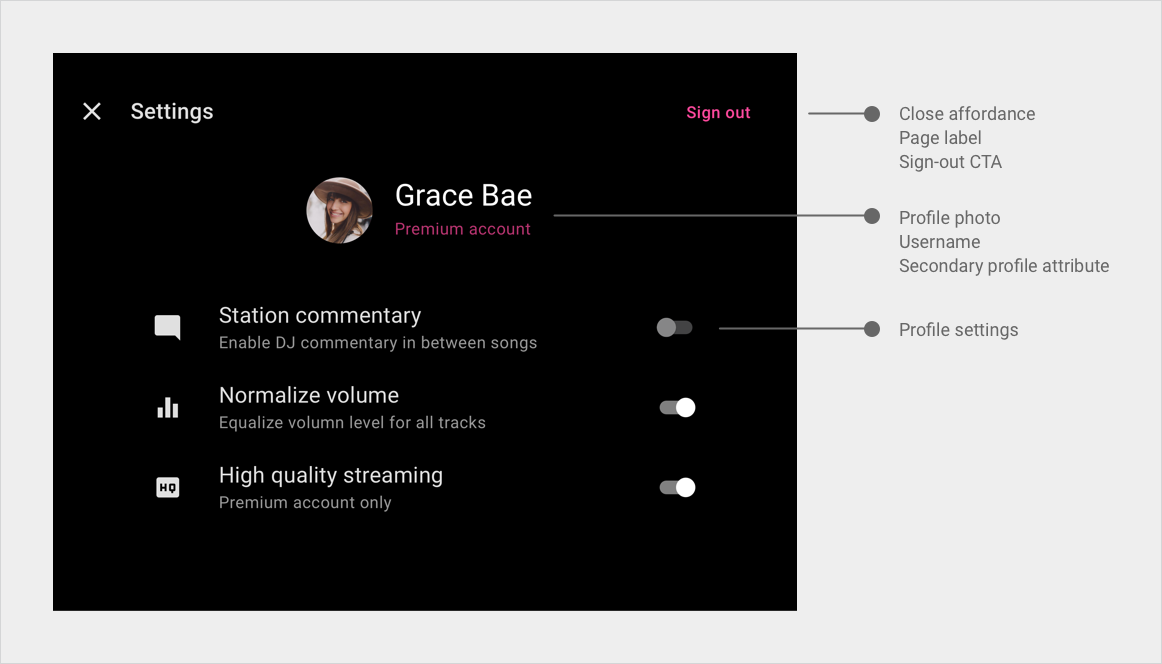بالإضافة إلى اتخاذ بعض القرارات بشأن الوصول إلى المحتوى وتسجيل الدخول إلى تطبيقك، قد تحتاج إلى تصميم شاشات الإعدادات.
إذا كنت ترغب في إتاحة إعدادات تطبيقك للمستخدمين، فأنت بحاجة إلى تصميم شاشة إعدادات، بالإضافة إلى شاشات لأي معالجة للأخطاء قد تكون مطلوبة. لمعرفة كيفية وصول المستخدمين إلى إعدادات تطبيقك، انتقِل إلى تسجيل الدخول والإعدادات والبحث.
أثناء تصميم تدفق الإعدادات، ضع في اعتبارك المتطلبات والإرشادات أدناه.
متطلّبات التصميم
حاليًا، تحتاج إلى تصميم إصدارات من شاشات الإعدادات لكل من التنسيقات العمودية والأفقية:
- تخطيط الوضع الرأسي لحجم الشاشة المستخدم في سيارة Volvo Polestar 2 (1068 × 1425 بكسل مستقل الكثافة؛ 1152 × 153 بكسل)
- تخطيط وضع أفقي لحجم الشاشة المستخدَم في تنفيذ Automotive المرجعي لشركة Google (1075 × 806 بكسل مستقل الكثافة، 1024 × 768 بكسل)
يمكنك استخدام المحاكي في "استوديو Android" لمعرفة كيفية ظهور التنسيقات في هذين التطبيقَين. يمكنك أيضًا الاطلاع على Layout للحصول على معلومات مرجعية حول كيفية تكييف تخطيطات شركات تصنيع السيارات مع أحجام الشاشات المختلفة (مع الأخذ في الاعتبار أن بعض التفاصيل مثل الهوامش وقيم المساحة المتروكة قد يتم تغييرها بواسطة الشركة المصنعة للسيارة).
مثال على الإعدادات والإرشادات
يتضمن شريط التطبيق في نموذج تطبيق الوسائط خيارًا للتحكم في الإعدادات، والذي يمكن للمستخدمين اختياره لإظهار تراكب في شاشة إعدادات التطبيق.

إرشادات الإعدادات
وبالإضافة إلى هذه الإرشادات، احرص على الرجوع إلى الإرشادات العامة حول النمط في إرشادات للشاشات المخصّصة.
| مستوى المتطلبات | الإرشادات |
|---|---|
| ينبغي |
على مطوّري التطبيقات:
|
الأسباب:
- تصميم السيارات: احرص على ضبط الإعدادات داخل السيارة على الحد الأدنى المطلوب للبيئة، وسهِّل العثور عليها واستخدامها.

